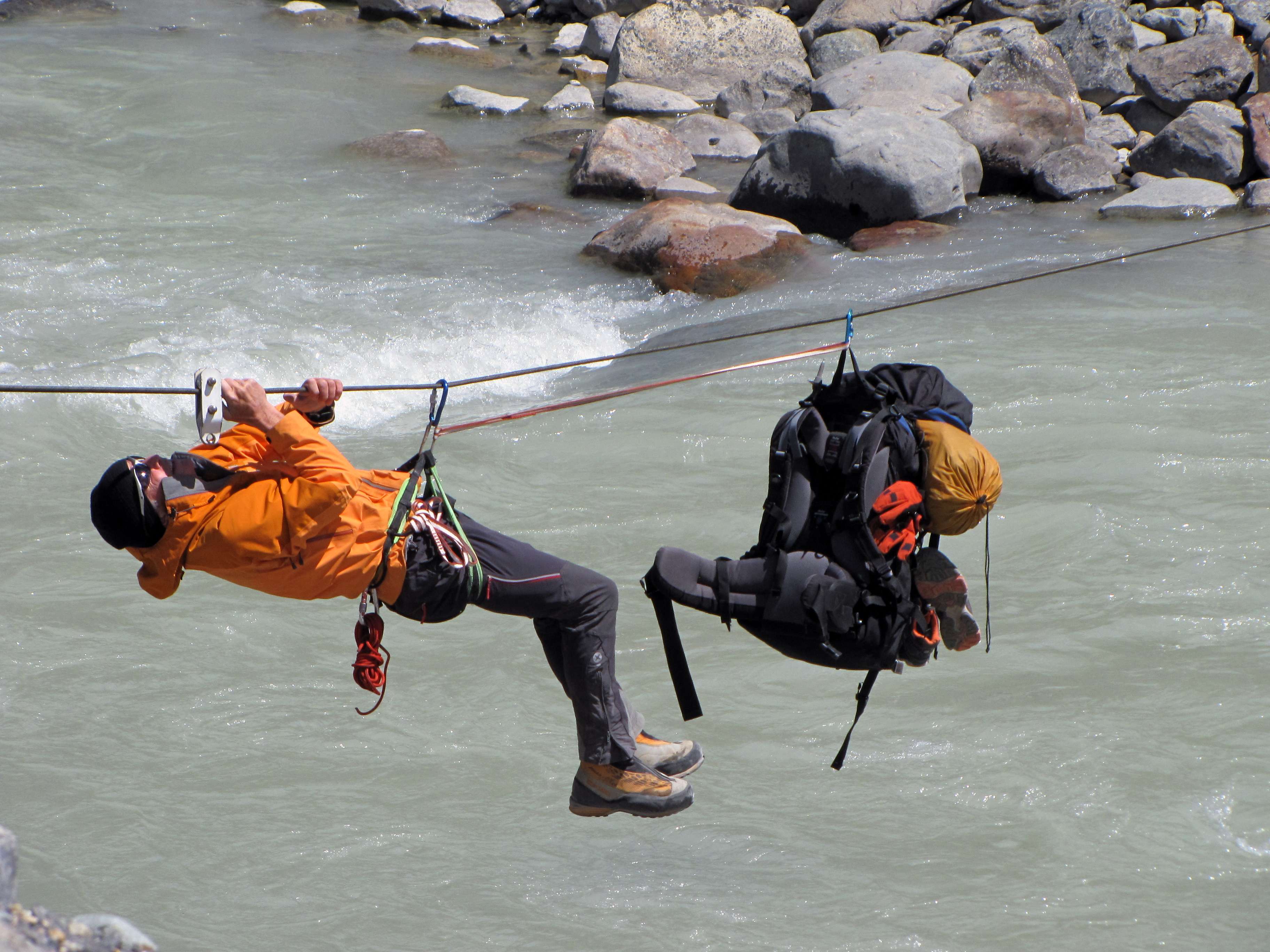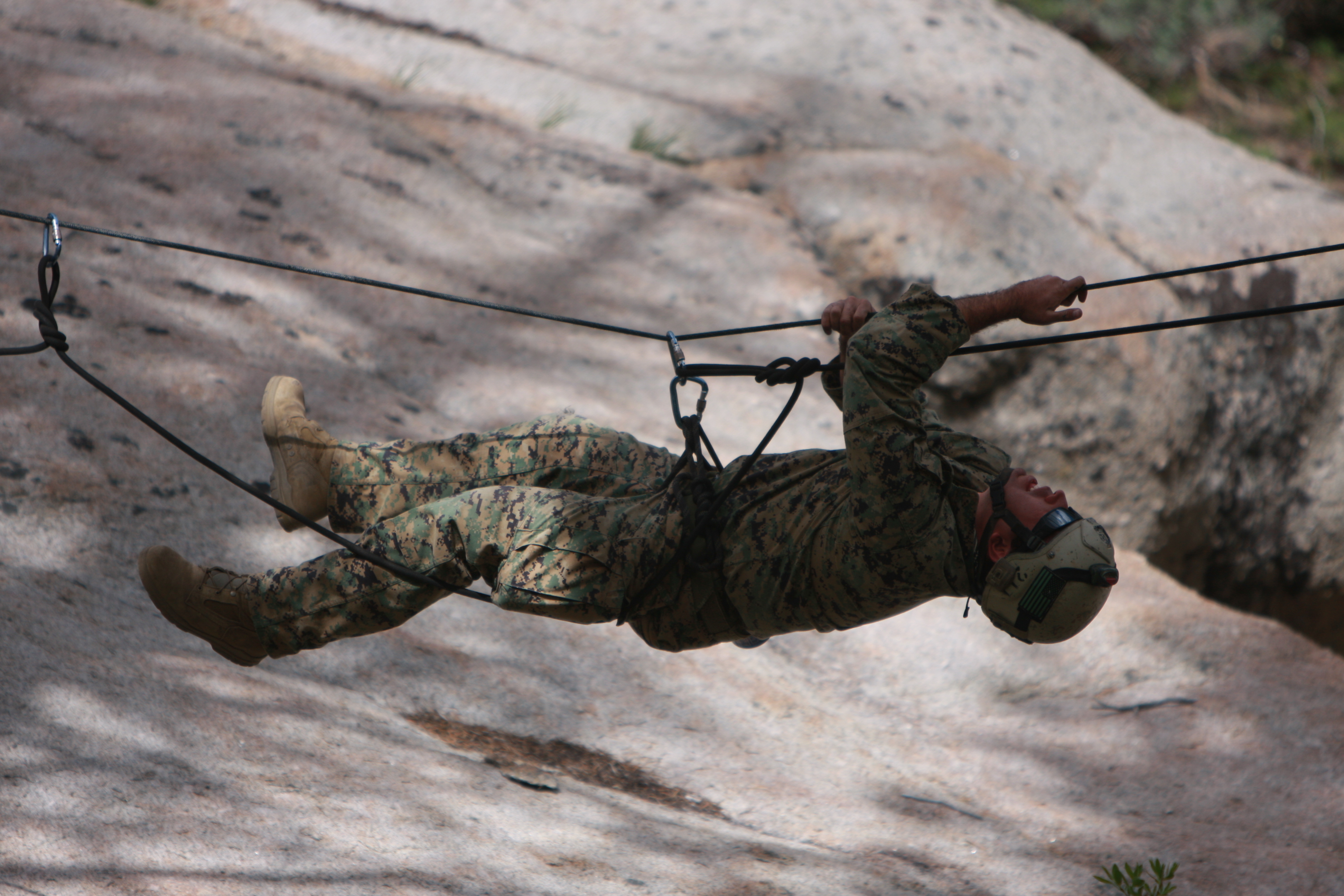Tyrolean traverse on:
[Wikipedia]
[Google]
[Amazon]


 A Tyrolean traverse is a method of crossing through free space between two high points on a rope without a hanging cart or cart equivalent. This is used in a range of mountaineering activities: rock climbing, technical tree climbing, caving, water crossings and mountain rescue. A zip-line is in essence a Tyrolean traverse which is traveled down quickly with the assistance of gravity. Several sources claim that the name comes from the Tyrolean Alps, where climbers are said to have developed the system in the late nineteenth and early twentieth centuries.
A Tyrolean traverse is a method of crossing through free space between two high points on a rope without a hanging cart or cart equivalent. This is used in a range of mountaineering activities: rock climbing, technical tree climbing, caving, water crossings and mountain rescue. A zip-line is in essence a Tyrolean traverse which is traveled down quickly with the assistance of gravity. Several sources claim that the name comes from the Tyrolean Alps, where climbers are said to have developed the system in the late nineteenth and early twentieth centuries.


 A Tyrolean traverse is a method of crossing through free space between two high points on a rope without a hanging cart or cart equivalent. This is used in a range of mountaineering activities: rock climbing, technical tree climbing, caving, water crossings and mountain rescue. A zip-line is in essence a Tyrolean traverse which is traveled down quickly with the assistance of gravity. Several sources claim that the name comes from the Tyrolean Alps, where climbers are said to have developed the system in the late nineteenth and early twentieth centuries.
A Tyrolean traverse is a method of crossing through free space between two high points on a rope without a hanging cart or cart equivalent. This is used in a range of mountaineering activities: rock climbing, technical tree climbing, caving, water crossings and mountain rescue. A zip-line is in essence a Tyrolean traverse which is traveled down quickly with the assistance of gravity. Several sources claim that the name comes from the Tyrolean Alps, where climbers are said to have developed the system in the late nineteenth and early twentieth centuries.
Description
In rock climbing, a Tyrolean traverse is most often used to return to the main part of a wall after climbing a detached pillar. Lost Arrow Spire, a detached pillar in Yosemite Valley, is often abseiled using a dramatic Tyrolean traverse. There are many ways to anchor the line at the two high points but the significant feature is that there is a line strung between them. Many classic locations for Tyrolean traverses have since been used as locations for "highlining" or " slacklining" (techniques which involve walking across the line like a tightrope, rather than hanging beneath) at great heights. In a sense completing such a slackline would count as a Tyrolean traverse but since slacklines are not typically used as a form of transportation this is not entirely accurate. With the rise in popularity of slacklining and the relative decline in the use of Tyrolean traverse by the climbing community, the terms "highlining" and "Tyrolean traverse" have been somewhat confused due to obvious overlaps in the nature of the activity, including preparation and location. Because Tyrolean traverses, and "highlines", have low tension they may sag significantly between the ends. The result is that they slope downhill at the beginning, and then uphill at some point along the traverse, with the lowest point being determined by the relative heights of each end. Traveling across a Tyrolean traverse can vary from using only one's hands and legs to the use of carabiners or pulleys, with prusiks, or ascenders when "progress capture" is required to prevent sliding back toward the low point due to the upward slope. In most modern situations the traverser is secured to the line through some combination ofclimbing harness
A climbing harness is a device which allows a climber access to the safety of a rope. It is used in rock and ice climbing, abseiling, and lowering; this is in contrast to other activities requiring ropes for access or safety such as industrial ...
, webbing, carabiner, and/or pulleys.
There are situations in which a Tyrolean traverse is a preferred way to descend a route, and a Tyrolean traverse may allow a climber to avoid a long multi-pitch rope rappel in favor of a walk-off (walking descent); or a Tyrolean traverse may allow the climber to avoid an undesirable or dangerous location such as a steep scree field.
Records
The longest Tyrolean traverse agreed by Guinness is 1550 meters. It was created on September 19th, 2008, in Rila mountain range in Bulgaria. Another famous Tyrolean traverse, set up in 2000, connected Castleton Tower and Rectory desert towers, which are about 500 meters apart.In popular culture
A famous use of a Tyrolean traverse in popular culture was in the opening scene of the 1993Sylvester Stallone
Sylvester Enzio Stallone (; born Michael Sylvester Gardenzio Stallone, ) is an American actor and filmmaker. After his beginnings as a struggling actor for a number of years upon arriving to New York City in 1969 and later Hollywood in 1974, h ...
film '' Cliffhanger'', where a mountain rescue climber (played by Stallone) unsuccessfully attempts to transport a woman across a high Tyrolean traverse, only to have her fall to her death. This scene was later spoofed in the Jim Carrey comedy film '' Ace Ventura: When Nature Calls''.
References
{{Climbing navbox Mountaineering techniques Climbing techniques Caving techniques es:Tirolina